IT'S ONE O'CLOCK; I climb down the stairs from Mounira’s apartment in Rue Chevreul, come out the white stone Hausmanian building, take a right up the Rue de Montreuil and cross Boulevard Voltaire to the bakery of my Sunday baguette. The flow of people on Voltaire is steady, calm and concentrated. No cars, no noise, only human voices below the helicopter buzz. A bunch of black kids converge from the Rue des Immeubles Industriels. The bare plane trees scrape the blue, mid-day sky.
This is the most Jewish neighbourhood in Paris now and the tension has been rampant these last two days. Whether selling shawarma pastries, flights to the Middle East or the finest poutargue in the world, most shops are Kosher here. We are a stone’s throw from the Porte de Vincennes where four Kosher shop customers were shot last Friday, almost live on TV.
We're in the 11th arrondissement at Place de la Nation. The powerful, generous and bronze super sexy monument almost looks down in our direction, rather more south towards Bastille, rolling her chariot and kin in her wake, probably planning to walk down along the famous Parisian revolutionary promenade across place de la Concorde, up the Champs Elysées and down again to the new Defense district.
The queue is short at the bakery and the baguette is warm. At the baker’s door, I buy the Journal du Dimanche from an old, African man who stands here every Sunday. I scold him for not having a pair of gloves - come on, it’s winter now! He scolds me for not wearing a cap - come on, you’re not a young man any more! I promise I will when I march. He gives me an approving wink.
We have another two hours before the march begins from place de la République. Back in the flat, the TV news shows a map of Paris where three red lines suggest possible itineraries for the marchers. A royal one on Voltaire; a traditional one on Beaumarchais, Filles du Calvaire, through Bastille and up to Nation on Diderot. The northern route takes Avenue de la République and arches through Boulevard Ménilmontant. Another news bulletin tells us that almost 50 heads of state are expected and will start walking from Place Léon Blum, next to the Mairie du 11e arrondissement. Netanyahou is among them. Abbas is also expected. Merkel became so friendly, even Cameron is concerned. Only Obama didn’t give the event much weight - this guy doesn’t understand what Europe is about anyway. Just a few minutes walk? Ask the commentator, but you don’t come a long way up to Paris just for a few minutes walk, do you? That burst of fame won’t make things easy for us to reach the Republic - I mean Place de la République.
We are out in the street, Mounira and I, at 2PM. The flow is much thicker, more present, more assertive. No cars. Some cop sirens towards Porte de Vincennes. Many people hold signs. Some say. 'Je suis Charlie'. Many send more subtle messages, some hold Charlie’s covers, no hostile sign, many pencils plugged in women’s hair.
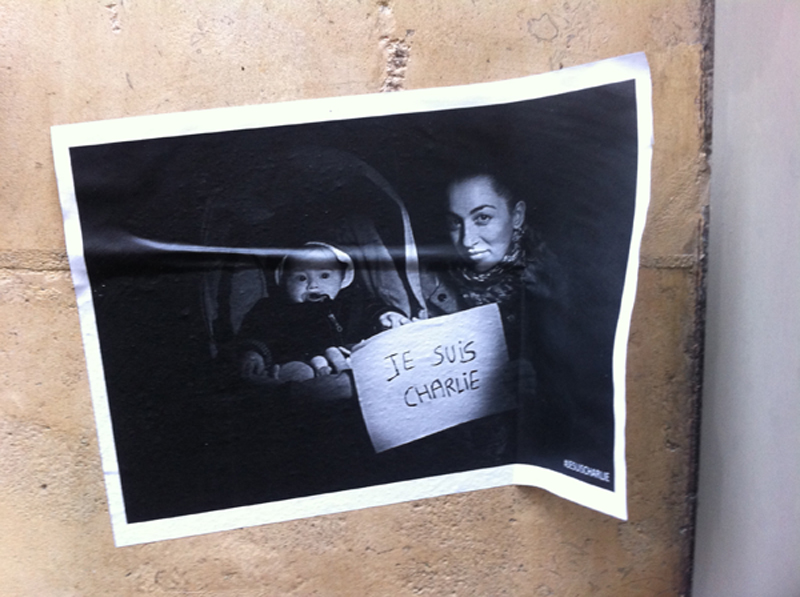
After hardly a fifteen minute walk, down to where Voltaire crosses with Charonne, a police line stops us from proceeding, inviting us to choose between north and south. North is Menilmontant where I don’t want to tiptoe across the Muslim fundamentalist district. There, pressure on women clothing shops had the dummies lose their heads in obedience. So we take a left on Rue de Charonne to join Voltaire further south. We’ll see.
The mellow and sunny weather is on our side. At each corner to the right on Charonne, an overflow of desperate marchers gesture that it’s all blocked ahead - don’t even try. It now becomes grossly apparent that the march is designed for the VIPs to be flaunted on TV. We decide it’s better to try and find the southern line of the demonstration on Boulevard des Filles du Calvaire.
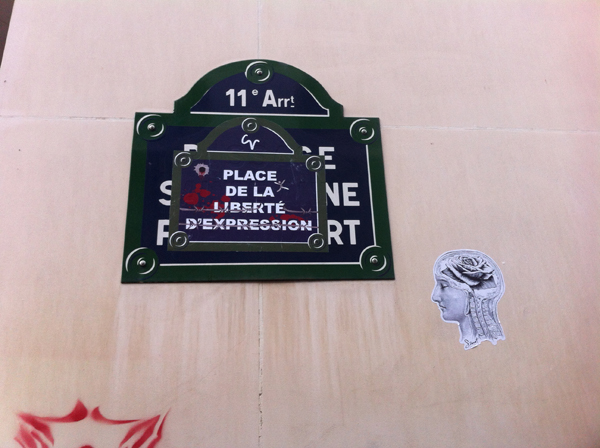
At one crossing the crowd crushes in congestion. We are at Charlie Hebdo Office where the first shooting took place on Wednesday. The Rue Nicolas Appert is renamed Place de la liberté d’expression - Freedom of Speech Square. Most people are serene. One holds a sign, ‘We know what we have to fight now: obscurantism!’ Hundreds of bunches of flowers have been thrown on Charlie Hebdo’s balcony. Red and white plastic ribbons float, bridging some streets. Huge boards filled with messages, drawings, quotations. Enormous images of Charb, Cabu, Wolinski and the others. On a bench, a display of photos edited by the Communist Party, showing the faces of the assassinated cartoonists. Marchers stop to pick their favourite. A journalist interviews a man wrapped in a black overcoat and white scarf who opts for a casual composure while clutching a microphone. A mom holding a five-year-old duffle-coated kid by the hand crouches down to attempt an explanation.
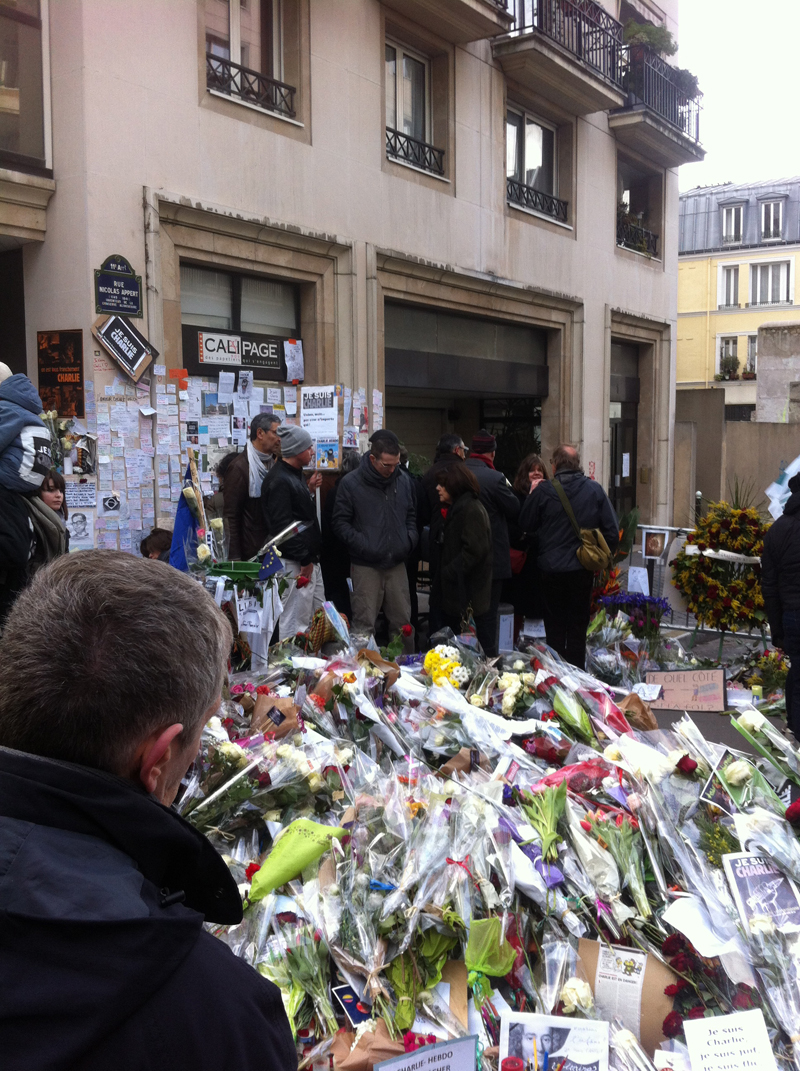
We zig and zag across the 11e arrondissement, take Rue Froment up to where Rue du Chemin Vert seems to promise an orthogonal side, and escape towards République. Thousands of people walk up and down searching the way in, asking one another, joking about this chaotic social event, exchanging familiar glances. Some bear signs or fix stickers to the gutterpipes. When we are in sight of Rue du Chemin Vert, shrill police whistles resound in our ears and, in the next minute, a series of violet Pullman buses drive along Boulevard Richard Lenoir between lines of metal fences. This is the VIP’s gathering. How can the police secure those hundreds of VIPs? I have no idea. I spent part of last night obsessed by the notion that dozens of suburban kids were probably daydreaming of shooting this oh-so-tempting collective target. It is hardly past 3 PM. The Place de la République must be overflowing by now.
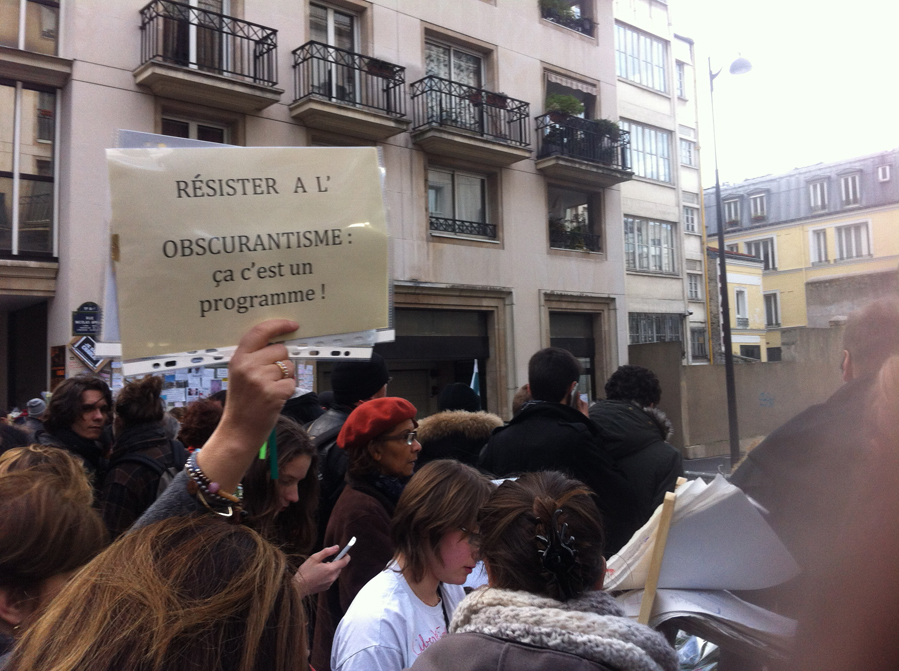
My memory brings back images of the previous huge demonstration here in Paris. More than one million had come to protest the profaning of Jewish graves in Carpentras. President Mitterrand had led the procession. I had spent over two hours stuck in the place de la République without being able to budge. I didn’t like it very much. Two days later it was revealed that the profanation had not been a Nazi provocation but a bad joke by a bunch of lost kids. Too much confusion. What’s the relation between lost kids, fascists or skinheads? Here and now, amidst this crowd, not too many bad kids I would guess. Mostly whitish, middle class bobos. We call bobo in Paris anyone who is both bourgeois and bohème - bobo. The bobos are everywhere to be seen here. They enjoy demonstrations, buy organic, bring up two kids, vote Green, live in Paris proper and read Le Monde.
We cross Richard Lenoir where the Sunday market has been postponed to dodge the march; we walk along Richard Lenoir upstream until we take a left on Alphonse Bodin. Then we reach Beaumarchais through Rue Saint Sébastien. Good shot. Here they are. We can already feel the slow pace of a densely packed demonstration on the Boulevard. In five minutes we are inside the heated mob. ‘Morts de rire,’ says a sign. A girl next to the signholder hands out leaflets and stickers repeating this red on white motto: ‘morts de rire’. The marchers are bouyed by Charlie’s wit.
Where are my suburban people? Almost no African Blacks and only a handful of North Africans. I didn’t see a single head-scarfed girl. Would the Muslims be hiding in fear of reprisals? I’d rather bet that many protesters didn’t want to share a demonstration with Netanyahou. In the morning, the latter made a statement saying that Israel was offering shelter to the endangered Jews of France. Please come under the Middle-eastern bombs and die for us! The French Prime minister answered that France wasn’t France anymore without her Jews. Prime time polemics. Then the same Netanyahou offered the assassinated customers of the Porte de Vincennes supermarket some sort of super graves in Jerusalem, on the Mount of Olives.
So many marchers pour down Beaumarchais now that we have to stop every few minutes to let the stream subside. On my right, a gay couple hold hands. Behind us, a whole family - parents, kids and grandma - keep a grave face. In the line previous to ours, a woman and a young black man carry on an intense discussion as if in a café. An actual café at the corner of Rue Amelot with Rue Pelée is packed with chatting beer and wine drinkers. Some smokers hold their glasses on the kerb while debating. The march invaded the adjacent streets, which are as densely filled as the Boulevard. On the roof of a bus stop shelter, a young girl with long blond hair sits, her legs dangling down. She seems to be searching for someone in the crowd; or she may be taken aback by the blackened Boulevard.
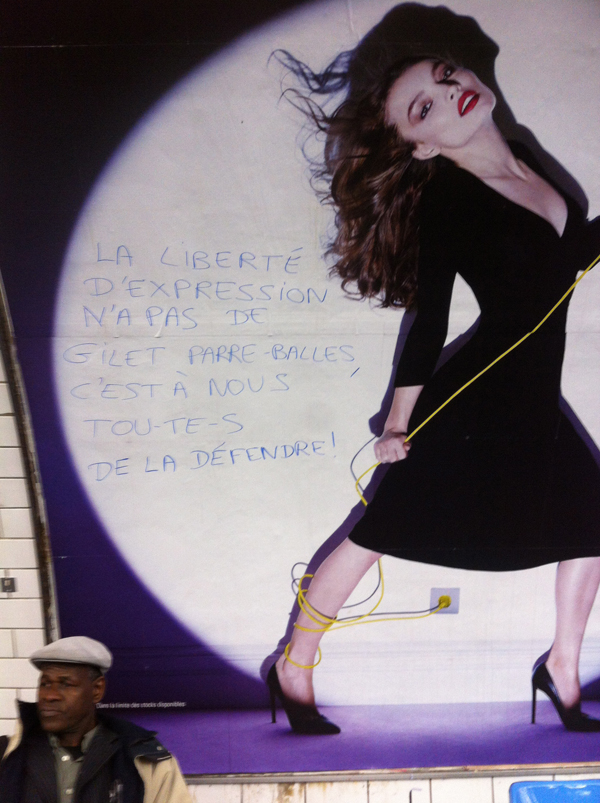
I shoot a glance up toward the roofs in expectation of police snipers. But none is in sight. From a fifth-floor balcony, well above the chestnut trees, a woman punctuates a chant with her clenched fist that the crowd echoes with rage. Has she been doing this for the past five hours? As we approach mid-afternoon, Bastille comes into sight, its winged genius shining gold in the twilight. The closer we are, the slower we march. How long have we been on Beaumarchais? Two hours maybe? Three?
On place de la Bastille, no smell of merguez teases our nostrils. I miss the hot north-African beef sausages that used to buck up the final steps of Parisian demonstrations. As we enter Bastille, a line of police buses drives down to the Seine. Through their open windows the officers wave to the demonstrators. Thanks for what you did! Thanks for being here! How could one ever imagine this scene in Paris?
The straight way up to Nation is through the Faubourg Saint Antoine. But how could the narrow Faubourg ever swallow our gigantic flow? Gridlock. Some marchers give up and catch the 91 bus to the left bank or step down to the metro. Some wander with us - haggard, lost. We make an attempt to circumscribe the square along the Opera house and try to squeeze in Rue de Charenton, next to the café Bastille. We are soon caught between a mob surging back in our direction and the pavement area of Les Grandes Marches. Behind the glass window of this three star restaurant adjoining the Opera, lazy customers ignore what fills and thrills the city. Let’s join Gare de Lyon and Diderot.
At one point a feeling of failing improvisation invades me. What are we doing here: a straight, white, well-off gathering offended that twelve cartoonists were shot dead for their drawings, when the daily news mentions hundreds of dead bodies every night in Nigeria, Syria and elsewhere. And elsewhere is so broad and remote that we have not enough voices to scream our rage. I recall a message signed by Ortiz after the 9/11 disaster in New York, begging silence for the hundreds of thousand dead in Palestine, Cambodia, Guatemala, South Africa, etc, under American-made bullets and bombs. Did we march for the several hundred girls captured and probably enslaved by Boko Haram last spring? Did we march to protest the bombing on Gaza civilians a few months back? Well, we’re here in Paris and we march.
Someone wrote that the British had Shakespeare, the Spaniards, Cervantes, the Italians, Dante and the Germans, Beethoven. The Greeks had the best share with so many philosophers and poets. The French have Paris. We still have it and Paris revives so many names and situations revered by Europeans! Would the murderers have attempted to kill Beethoven, all Europe would be marching in Germany. Same with Dante or Aristotle. Paris is a memory of so many revolutions, upheavals, popular outrages that they became part of a global memory. Here, Place de la Bastille, where the great Revolution began, the golden Genius reminds us of “the citizens of Paris who armed and fought for the defence of public liberties on the glorious days of 27, 28 and 29 July 1830”. Up to 1968, angry mobs have threatened established powers for centuries. The idea behind those so-called French revolutions is a furious sense of freedom and community. The French are oblivious of historical facts, but when desperate, they jump in their boots and can even die for the right to ridicule the powerful. Twelve journalists were shot for making fun of all fundamentalisms. Their point was not to offend the believers, but to free anyone from the grasp of obscurantism. What about the Jews? Would plain deadly antisemitism be back for good? What about the cops? What’s going on here?
We eventually reach Charenton near the hospital for the blind, the Quinze-Vingt. The procession here seems disbanded like a vacation stroll. Better try to join the Faubourg, reckons Mounira, if only to have a Belgian beer at En Attendant l’or, at the final stretch before Nation. The Faubourg is packed but the beer is out of reach. Too many marchers fight for their thirst at the counter. I suggest we’ll sip our beer at the Extra Old café where I have my morning habit. Yes, let’s climb up there on Rue de Montreuil. When close to reaching Voltaire, we are at the crossing where I bought my baguette five hours ago; there is no way to join the party. It’s a full night now. Paris is in its glad rags, the nyctalopian Paris that we love best. No hope to move up though. We queue, standing about for the mob to dissolve in the metro and RER. Then a rumble comes from the distance. What rumble?
Where Rue de Montreuil feeds into Voltaire, on our left side, walking towards Nation, a huge puppet of a white, mournful République dances with the rhythm of a dozen drums. Her very red mouth is wide open as she lifts her arms in despair or glory. She rocks back and forth, tilting her head, escaping the black menace of deadly flies, addressing the mob in ire. This is Ariane Mnouchkine and the Théâtre du Soleil marching with us. From the 5th floor connected balconies, people clap in unison. Hundreds of mobile phones held by outstretched arms above heads snatch photos from the pavement. We accompany this wild République into the place de la Nation. There she is, there she goes. So do we.
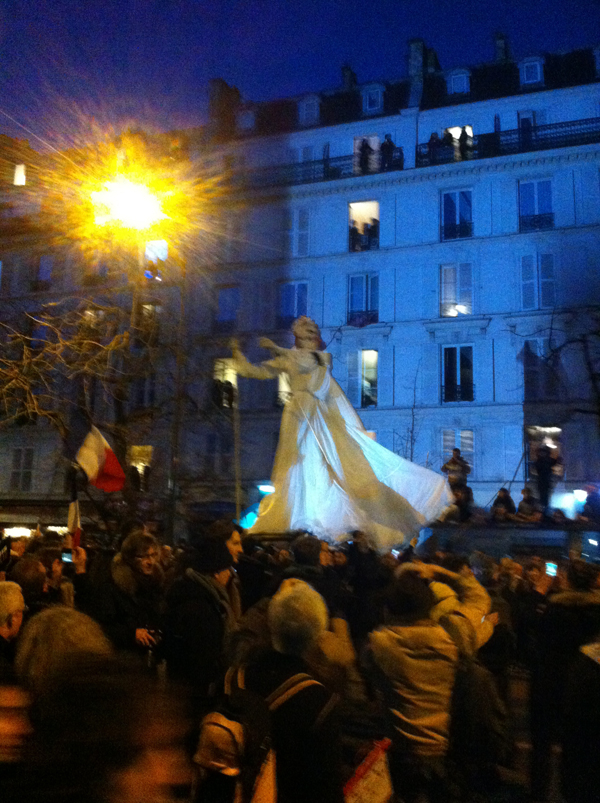
We have done our share. The Extra Old café is too packed for us to attempt our favourite Copère beer. We walk down the Faubourg, take a right angle into Rue des Boulets and walk down our dear neighbourhood arm in arm as if nothing had happened. Here is the promised beer in the newly opened Irish pub. It is as full as on the final match of a Five Nations rugby tournament. I elbow my way to the counter and grab two pints of pale ale that I bring to the table where Mounira sits, already chatting with a bunch of excited marchers. The young girl next to me comes from Aveyron, what we call deep France, down south in the Massif Central. She couldn’t have let those murders go unanswered. You can’t kill people for their drawings. Those guys were our insolent artists. She loves Paris but goes back home every month. Gallons of fresh beer come on trays carried by swift Irish girls, everyone chats and argues from table to table. The pub is Charlie for a couple of nights.
Marc Hatzfeld
Marc Hatzfeld is a social anthropologist living in
Paris and working (both as a researcher and a consultant) on
subjects such
as homelessness, juvenile delinquency, immigration, suburban
life and respect. His recent books include Petit
Traité de
la banlieue (2004), Les Dézingués (2006), La
culture des cités (2006) and Petites fabriques de
la démocratie (2007).
Marc's new book, The Poetics of Land: A personal journey through the stories, ideas and images of land and people in Bengal, from Vedic times to Nandigram is due to be published by Black Apollo Press, May 2015.
![]()